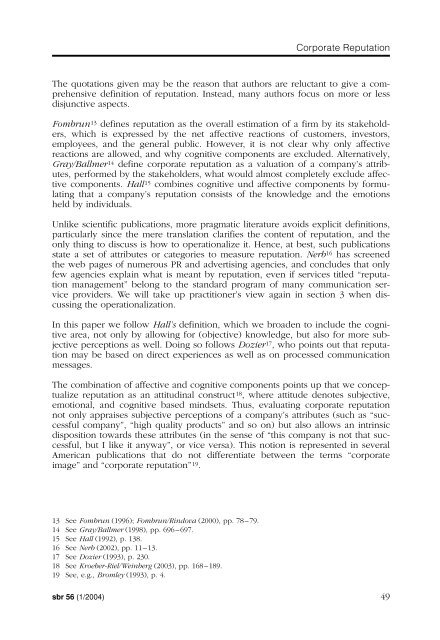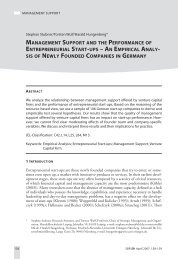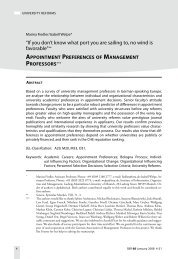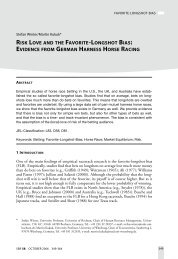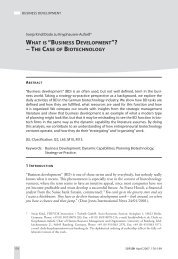components and parameters of corporate reputation - sbr ...
components and parameters of corporate reputation - sbr ...
components and parameters of corporate reputation - sbr ...
Create successful ePaper yourself
Turn your PDF publications into a flip-book with our unique Google optimized e-Paper software.
Corporate Reputation<br />
The quotations given may be the reason that authors are reluctant to give a comprehensive<br />
definition <strong>of</strong> <strong>reputation</strong>. Instead, many authors focus on more or less<br />
disjunctive aspects.<br />
Fombrun 13 defines <strong>reputation</strong> as the overall estimation <strong>of</strong> a firm by its stakeholders,<br />
which is expressed by the net affective reactions <strong>of</strong> customers, investors,<br />
employees, <strong>and</strong> the general public. However, it is not clear why only affective<br />
reactions are allowed, <strong>and</strong> why cognitive <strong>components</strong> are excluded. Alternatively,<br />
Gray/Ballmer 14 define <strong>corporate</strong> <strong>reputation</strong> as a valuation <strong>of</strong> a company’s attributes,<br />
performed by the stakeholders, what would almost completely exclude affective<br />
<strong>components</strong>. Hall 15 combines cognitive und affective <strong>components</strong> by formulating<br />
that a company’s <strong>reputation</strong> consists <strong>of</strong> the knowledge <strong>and</strong> the emotions<br />
held by individuals.<br />
Unlike scientific publications, more pragmatic literature avoids explicit definitions,<br />
particularly since the mere translation clarifies the content <strong>of</strong> <strong>reputation</strong>, <strong>and</strong> the<br />
only thing to discuss is how to operationalize it. Hence, at best, such publications<br />
state a set <strong>of</strong> attributes or categories to measure <strong>reputation</strong>. Nerb 16 has screened<br />
the web pages <strong>of</strong> numerous PR <strong>and</strong> advertising agencies, <strong>and</strong> concludes that only<br />
few agencies explain what is meant by <strong>reputation</strong>, even if services titled “<strong>reputation</strong><br />
management” belong to the st<strong>and</strong>ard program <strong>of</strong> many communication service<br />
providers. We will take up practitioner’s view again in section 3 when discussing<br />
the operationalization.<br />
In this paper we follow Hall’s definition, which we broaden to include the cognitive<br />
area, not only by allowing for (objective) knowledge, but also for more subjective<br />
perceptions as well. Doing so follows Dozier 17, who points out that <strong>reputation</strong><br />
may be based on direct experiences as well as on processed communication<br />
messages.<br />
The combination <strong>of</strong> affective <strong>and</strong> cognitive <strong>components</strong> points up that we conceptualize<br />
<strong>reputation</strong> as an attitudinal construct 18, where attitude denotes subjective,<br />
emotional, <strong>and</strong> cognitive based mindsets. Thus, evaluating <strong>corporate</strong> <strong>reputation</strong><br />
not only appraises subjective perceptions <strong>of</strong> a company’s attributes (such as “successful<br />
company”, “high quality products” <strong>and</strong> so on) but also allows an intrinsic<br />
disposition towards these attributes (in the sense <strong>of</strong> “this company is not that successful,<br />
but I like it anyway”, or vice versa). This notion is represented in several<br />
American publications that do not differentiate between the terms “<strong>corporate</strong><br />
image” <strong>and</strong> “<strong>corporate</strong> <strong>reputation</strong>” 19.<br />
13 See Fombrun (1996); Fombrun/Rindova (2000), pp. 78 – 79.<br />
14 See Gray/Ballmer (1998), pp. 696 – 697.<br />
15 See Hall (1992), p. 138.<br />
16 See Nerb (2002), pp. 11 – 13.<br />
17 See Dozier (1993), p. 230.<br />
18 See Kroeber-Riel/Weinberg (2003), pp. 168 – 189.<br />
19 See, e.g., Bromley (1993), p. 4.<br />
<strong>sbr</strong> 56 (1/2004) 49


